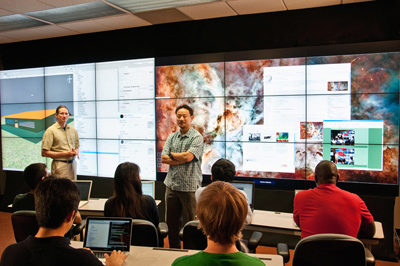Advanced Cyber-Classroom Opens at the University of Illinois at Chicago
July 14th, 2009
Categories: Devices, Education, Multimedia, Networking, Software, User Groups, Visualization

About
To see this article and other National Science Foundation news items see science360 News Service
July 14, 2009
CHICAGO, IL - The newest cyber-commons at the University of Illinois at Chicago is a feat of electronic hardware that builds up one wall while tearing down another.
Starting this fall, UIC students studying visualization and visual analytics, video game design, scientific visualization, and virtual reality will meet at the Electronic Visualization Laboratory’s (EVL) cyber-commons, a high-tech classroom and meeting space outfitted with a high-definition display wall with nearly 19-million-pixels of contiguous workspace and 20Gbps of networking.
A cyber-commons is a technology-enhanced meeting room that supports local and distance collaboration and promotes group-oriented problem solving.
“In the past, these high-performance environments have been hidden away in research laboratories and used exclusively by researchers,” said EVL director and UIC associate professor of computer science Jason Leigh. “This cyber-commons opens up the technology to large student populations so that we can better understand the role of high-performance and ubiquitous computing in future classrooms.”
EVL first prototyped cyber-commons in its research lab in 2005; the LambdaVision 17-foot-wide by 6-foot-high tiled display wall of 55 LCD panels has been regularly used by faculty, staff and students for weekly technical meetings. EVL built a second, more economical cyber-commons for the Computer Science department in 2008 as an out-of-classroom meeting space for UIC students, complete with a high-definition display screen and video-teleconferencing capabilities.
EVL researchers and remote colleagues have been building and using these group research environments for the past four years to develop and test streaming middleware, participate in distributed network experiments, conduct user interaction studies, and display scientific data. The new EVL cyber-commons incorporates several years of computer science research and is designed to give the current generation of students raised on video games the ultimate learning environment.
A 20-foot-wide by 6-foot-high tiled high-definition display wall is the eye-popping centerpiece. It can support a montage of streamed and local digital media and information - from high-resolution images and animations to websites, PowerPoint slides, and students’ laptop display screens so all can see.
The tiled displays, connected to data sources over high-speed networks, allow students to create electronic posters in real time by providing easy access to remote Gigabyte visualization data objects, just as the Web makes access to remote lower-resolution images today. Launching, juxtaposing, and resizing the content are done using a gyroscopic mouse, or remotely using a laptop.
The scale and configuration of the EVL cyber-commons is optimized for a class of 40 students. Currently, a single computer drives all 18 displays (the economy version); this fall it will be replaced by a computer cluster so that users can simultaneously access and display ultra-high-resolution images from large-scale supercomputing simulations, instrumentation, or data stores.
Enabling the nearly seamless workspace are NEC’s new ultra-thin bezel LCD displays, just 7mm thick when tiled edge-to-edge within the framing, virtually eliminating the “window pane” effect evident in older tiled LCD walls. EVL’s 105-million-pixel LambdaVision, built four years ago using commercially available thicker-framed LCDs, has a noticeable 35mm tiled borders.
“Among the areas we’ll be investigating using this new cyber-commons are the relative advantages of juxtaposing lots of information, and whether it results in efficient problem solving,” said UIC associate professor of computer science Andy Johnson, who co-designed the new system with Leigh. For example, UIC anatomy students have used EVL’s display to compare and contrast several high-resolution anatomical images placed side-by-side.
“Our students are among the earliest adopters of this emerging class of display systems that will someday be as ubiquitous as the sliding blackboards found in university lecture halls today,” said Leigh. “The latest EVL cyber-commons leverages our experience with LambdaVision and how we’ve used it for the past four years for technical meetings, as a way to transform research. Now we are pushing that knowledge out to help transform education, too.”
In mid-August, the EVL cyber-commons will be used for a one-week “Many-Core Processors” course developed by the Virtual School of Computational Science and Engineering of the Great Lakes Consortium for Petascale Computation. The distributed weeklong seminar will be streamed from University of Illinois at Urbana-Champaign’s National Center for Supercomputing Applications.
UIC’s new Health Sciences Visualization and Simulation Center, opening in late fall 2009 or spring 2010, will likely build the fourth cyber-commons on campus.
Tiled LCD displays driven by a computer cluster connected to a high-speed network is rapidly becoming the de facto way of displaying high-resolution scientific data in university research laboratories and corporate research laboratories worldwide, spurred in large part through the efforts of the National Science Foundation-funded OptIPuter project members at UIC and the University of California, San Diego.
Contact
Laura Wolf
laura @ evl.uic.edu
About Electronic Visualization Laboratory, University of Illinois at Chicago
The Electronic Visualization Laboratory (EVL) at University of Illinois at Chicago (UIC) is a graduate research laboratory specializing in the research and development of networked, high-resolution visualization, collaboration and virtual-reality display hardware and software systems, and the design and implementation of international networking infrastructure. It is a joint effort of UIC’s College of Engineering and School of Art and Design, and represents the oldest formal collaboration between engineering and art in the country offering graduate MS, PhD and MFA degrees. EVL has received worldwide recognition for developing the original CAVE™ and ImmersaDesk™ virtual reality systems, and, more recently, the GeoWall low-cost stereo display, the 105-Megapixel LambdaVision tiled display wall and the Varrier autostereoscopic display. EVL is a founding member of StarLight and the Global Lambda Integrated Facility (GLIF), and is a lead institution of the NSF-funded OptIPuter project.